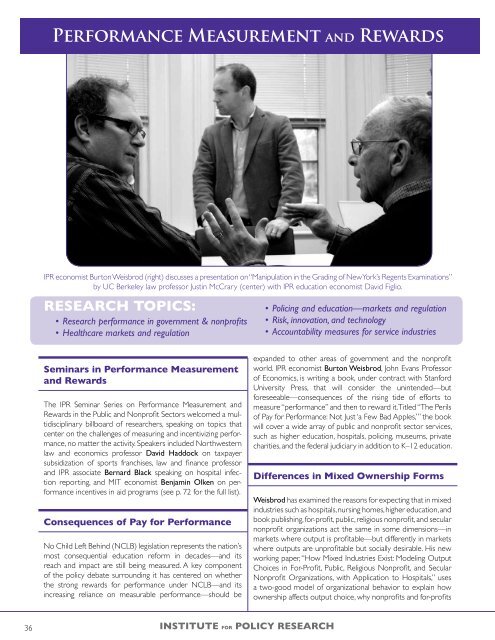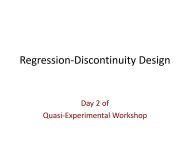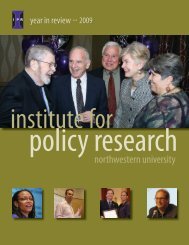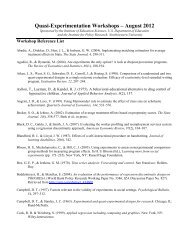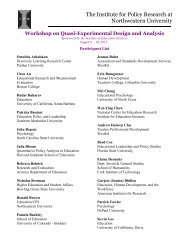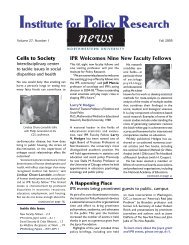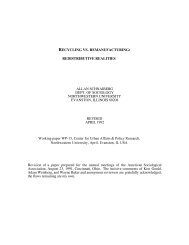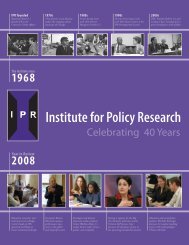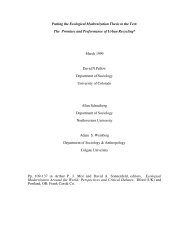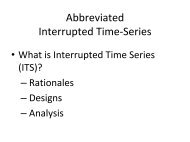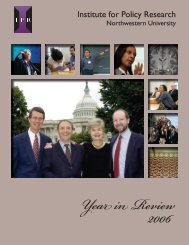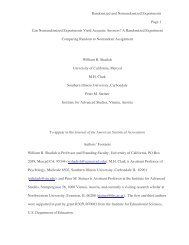Highlights of 2011 - Institute for Policy Research - Northwestern ...
Highlights of 2011 - Institute for Policy Research - Northwestern ...
Highlights of 2011 - Institute for Policy Research - Northwestern ...
Create successful ePaper yourself
Turn your PDF publications into a flip-book with our unique Google optimized e-Paper software.
Per<strong>for</strong>mance Measurement and Rewards<br />
IPR economist Burton Weisbrod (right) discusses a presentation on “Manipulation in the Grading <strong>of</strong> New York’s Regents Examinations”<br />
by UC Berkeley law pr<strong>of</strong>essor Justin McCrary (center) with IPR education economist David Figlio.<br />
RESEARCH TOPICS:<br />
• <strong>Research</strong> per<strong>for</strong>mance in government & nonpr<strong>of</strong>its<br />
• Healthcare markets and regulation<br />
• Policing and education—markets and regulation<br />
• Risk, innovation, and technology<br />
• Accountability measures <strong>for</strong> service industries<br />
Seminars in Per<strong>for</strong>mance Measurement<br />
and Rewards<br />
The IPR Seminar Series on Per<strong>for</strong>mance Measurement and<br />
Rewards in the Public and Nonpr<strong>of</strong>it Sectors welcomed a multidisciplinary<br />
billboard <strong>of</strong> researchers, speaking on topics that<br />
center on the challenges <strong>of</strong> measuring and incentivizing per<strong>for</strong>mance,<br />
no matter the activity. Speakers included <strong>Northwestern</strong><br />
law and economics pr<strong>of</strong>essor David Haddock on taxpayer<br />
subsidization <strong>of</strong> sports franchises, law and finance pr<strong>of</strong>essor<br />
and IPR associate Bernard Black speaking on hospital infection<br />
reporting, and MIT economist Benjamin Olken on per<strong>for</strong>mance<br />
incentives in aid programs (see p. 72 <strong>for</strong> the full list).<br />
Consequences <strong>of</strong> Pay <strong>for</strong> Per<strong>for</strong>mance<br />
No Child Left Behind (NCLB) legislation represents the nation’s<br />
most consequential education re<strong>for</strong>m in decades—and its<br />
reach and impact are still being measured. A key component<br />
<strong>of</strong> the policy debate surrounding it has centered on whether<br />
the strong rewards <strong>for</strong> per<strong>for</strong>mance under NCLB—and its<br />
increasing reliance on measurable per<strong>for</strong>mance—should be<br />
expanded to other areas <strong>of</strong> government and the nonpr<strong>of</strong>it<br />
world. IPR economist Burton Weisbrod, John Evans Pr<strong>of</strong>essor<br />
<strong>of</strong> Economics, is writing a book, under contract with Stan<strong>for</strong>d<br />
University Press, that will consider the unintended—but<br />
<strong>for</strong>eseeable—consequences <strong>of</strong> the rising tide <strong>of</strong> ef<strong>for</strong>ts to<br />
measure “per<strong>for</strong>mance” and then to reward it. Titled “The Perils<br />
<strong>of</strong> Pay <strong>for</strong> Per<strong>for</strong>mance: Not Just ‘a Few Bad Apples,’” the book<br />
will cover a wide array <strong>of</strong> public and nonpr<strong>of</strong>it sector services,<br />
such as higher education, hospitals, policing, museums, private<br />
charities, and the federal judiciary in addition to K–12 education.<br />
Differences in Mixed Ownership Forms<br />
Weisbrod has examined the reasons <strong>for</strong> expecting that in mixed<br />
industries such as hospitals, nursing homes, higher education, and<br />
book publishing, <strong>for</strong>-pr<strong>of</strong>it, public, religious nonpr<strong>of</strong>it, and secular<br />
nonpr<strong>of</strong>it organizations act the same in some dimensions—in<br />
markets where output is pr<strong>of</strong>itable—but differently in markets<br />
where outputs are unpr<strong>of</strong>itable but socially desirable. His new<br />
working paper, “How Mixed Industries Exist: Modeling Output<br />
Choices in For-Pr<strong>of</strong>it, Public, Religious Nonpr<strong>of</strong>it, and Secular<br />
Nonpr<strong>of</strong>it Organizations, with Application to Hospitals,” uses<br />
a two-good model <strong>of</strong> organizational behavior to explain how<br />
ownership affects output choice, why nonpr<strong>of</strong>its and <strong>for</strong>-pr<strong>of</strong>its<br />
36 INSTITUTE FOR POLICY RESEARCH


